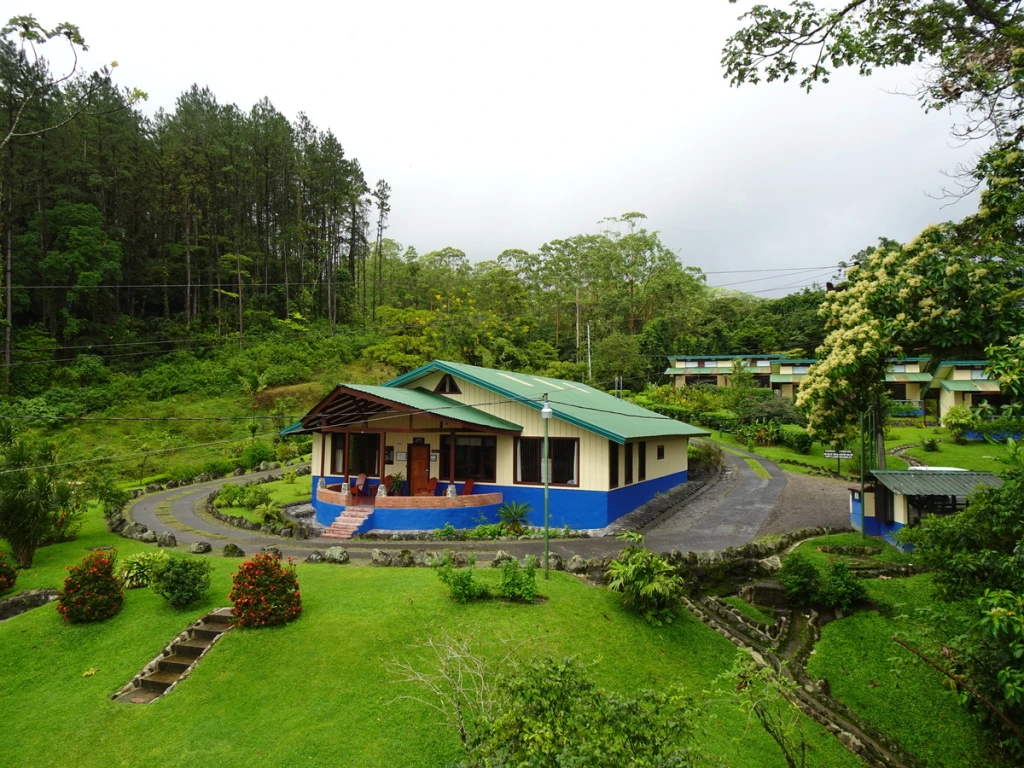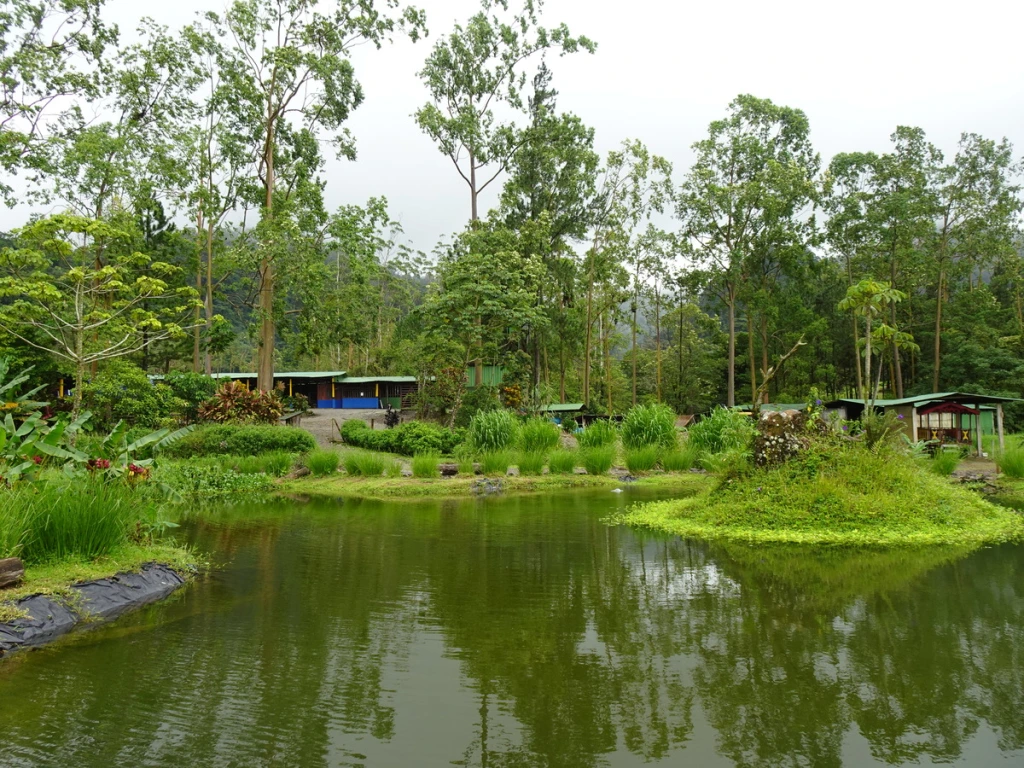When planning our trip to Costa Rica, there were no ifs, buts or maybes about including Arenal Volcano National Park in our itinerary: the chance to spend our days wildlife-watching on the trails and an evening soaking in a hot spring was too good an opportunity to pass up. Plus, it’s home to Costa Rica’s most iconic volcano. What’s not to like?
GETTING TO ARENAL OBSERVATORY LODGE (AOL)
Travelling within Costa Rica by public transport can be – and certainly was, in our experience – very slow. Which is fine if you have oodles of time on your hands, but for us it wasn’t worth spending another full day on the road to get from Puerto Jiménez to Arenal Observatory Lodge, 450-odd kilometres to the north. Enter, Sansa: Costa Rica’s domestic airline.
Puerto Jiménez Airport operates out of a corrugated iron outbuilding by the runway, on the south-east side of town. Not knowing quite what to expect, we arrived with plenty of time before our flight was due to depart. We needn’t have worried: the office (the blue room in the picture below) was shut, and didn’t even open until about an hour before our flight was due to depart.
When we checked in, they weighed our bags (so far, so normal) and then us (not something I’m used to). We were issued with laminated boarding passes – a novelty for us, though it did make sense as an eco-friendly alternative to printing disposable tickets daily. And then we were ushered across to the runway to board our plane. As it was such a tiny plane, everyone had a window seat.
People will tell you Costa Rica is very green, but it wasn’t until we saw it from the air that I really appreciated that. By the late 1980s, Costa Rica had lost between a third and half of its forest cover due to deforestation. At this point, the government stepped in: it made it illegal to log forests without approval from authorities, and introduced financial incentives to support its people in rewilding the country. We had seen a small piece of this puzzle at Cloudbridge Nature Reserve – but from the sky, you could see the scale of this small country’s vision to restore its biodiversity. I pretty much spent the entire forty-five-minute flight gawping at the views.

When adding Arenal Volcano National Park to your itinerary, you’ll need to choose between:
- Making the busy tourist mecca of La Fortuna, with its abundant amenities and selection of budget-friendly accommodation, your base;
- Trading amenities for tranquillity, and opting for somewhere closer to Lake Arenal.
We went with Option 2, and spent four nights at Arenal Observatory Lodge, which is the only accommodation located within Arenal Volcano National Park. Friends who had stayed there previously had recommended it, and as our priority was wildlife-watching this decision was a no-brainer for us.

OBSERVATORY MUSEUM
Our first afternoon was deliberately low-key: a late lunch of fajitas (for me) and fish tacos (for Laurence), followed by a visit to the museum and a wander round the frog pond. Although small, the museum’s displays provided an informative overview of the geology and history of the local area. Neighbouring Cerro Chato experienced its last eruption in c. 1500 BC, and its slopes are covered in dense forest. Arenal Volcano, on the other hand, put La Fortuna firmly on the map when it exploded in July 1968, after centuries of inactivity. Prior to the eruption, many locals were blissfully unaware that the forested slopes of the hill they farmed around concealed a dormant volcano. Nearby towns, including Tabacón and Pueblo Nuevo, were destroyed by the eruption, and 87 people lost their lives.
A decade later, a Costa Rican man named Alex Murray purchased 870 acres of abandoned farmland. This would, in time, become Arenal Observatory Lodge. Eucalyptus and Caribbean pines were planted to stabilise the soils and create habitats for wildlife, and in 1982 the first lodging – ‘La Casona’ – was built. As the road conditions were poor, the family stayed here whilst they worked on the land; day trips from San José were out of the question.
In 1987, volcanologists from the Universidad Nacional de Costa Rica and the Smithsonian Institute of Miami visited La Casona. At this point in time, there was no accommodation for researchers. Camping here enabled easy access to the volcano and relative safety. The following year, cabins were constructed for the volcanologists and a seismograph (now displayed in the museum) was installed to monitor the volcano’s activity. By 1990, the property featured a number of cabins for tourists.
Arenal Volcano National Park was established in 1991, and in 1992 Alex Murray sold the property to his in-laws. Since then, they have expanded Arenal Observatory Lodge and Trails whilst maintaining their focus on sustainable and responsible tourism. Arenal Volcano erupted, on and off, for forty-two years; during this time, it was considered one of the most active volcanoes in the world. Although it is now dormant, the slopes and summit remain off-limits to visitors. (Fear not, there are plenty of tourist-friendly trails for you to explore and enjoy the views from a safe distance.)
After refuelling at COATI Coffee and Smoothie Bar, we ventured over to the Frog Pond. We quickly discovered that the best times to visit are before breakfast or late afternoon, as this is when the frogs tend to be more active. Over the course of our stay, I amassed rather a lot of photos of the different frogs – including, unintentionally, one of a frog taking a dump – and we managed to see almost all of the different species on the sign.
EXPLORING AOL’S TRAILS
We spent roughly two-and-a-half days exploring the assorted trails at Arenal Observatory Lodge. You definitely don’t need this much time, but it does give you the opportunity to revisit trails and see the wildlife at different times of day.
One of the perks of staying at Arenal Observatory Lodge is the free guided tour, available at 08.00 or 10.00. Each guest is entitled to one free tour during their stay, and you must confirm your chosen date and time with reception in advance. We opted to do the tour on our first full day, to help us get our bearings. I would recommend doing the earlier tour, as these tended to have smaller groups. Our guide, Cristian, was chatty and enthusiastic, and shared lots of information about the different creatures we saw (including a red-legged honey creeper, various colourful hummingbirds, spider monkeys and lots of sleepy frogs!).
After this, we set off to explore the extensive network of trails around Arenal Observatory Lodge. From the aptly-named Green Gate, we first followed the Culebra Trail. (Although culebra is the Spanish word for snake, we didn’t see any on this trail.) If you’re short on time, I would probably skip this one: there are some nice plants, but nothing particularly note-worthy.
Next up was the Danta Waterfall Trail, which we reached at roughly the same time as a large tour group. As we neared Danta Waterfall, the path became a little slippery. We waited for the tour group to take their photos (it quickly transpired that they were on a brisk schedule and wouldn’t be allowed to linger for long), before taking some of our own. Whilst the waterfall was sizeable, we didn’t think it was the best one on the trails. (Ssh, don’t tell the tour groups that!)
With the Danta Bridge (and the tour group) behind us, we picked up the Yellow Trail. This led towards the picturesque laguna (lagoon), fringed by small purple flowers.

We then retraced our footsteps along the Yellow Trail, turning right when the path forked to join the Brown Trail. We saw only a handful of people on the trails beyond this point. Perhaps farmland simply didn’t hold the same appeal as forest for some visitors, or maybe the downpours put some people off venturing further out. Either way, it made for a nice, peaceful walk for us.
We were slightly baffled by the set of monkey bars positioned over a shallow stream, but it later transpired this was part of the Arenal CrossFit Challenge – an 8km route encompassing trail running and various ‘fitness stations’. (Or, in other words, not my idea of fun.)
Anyway, I digress. At the end of the Brown Trail, we turned right onto the Blue Trail. This (and the various offshoots of it which led to ‘Seasonal Waterfalls’, including Los Cangrejos Trail) turned out to be one of my favourites. The smaller paths leading down to each of these waterfalls from the Blue Trail were a little muddy and slippery in places. Wear suitable footwear and this shouldn’t cause any issues. These ‘Seasonal Waterfalls’ were undoubtedly a perk of visiting in the rainy season.
Shortly after turning onto Los Cangrejos Trail, we spotted this little fella with beautiful iridescent green feathers:
We soon reached the final waterfall, which was an impressive height compared to the earlier waterfalls. (We returned to this trail on our final day, and glimpsed a squadron of peccaries charging through the bushes below us, so it just goes to show that different days bring different experiences with the local wildlife.) Between downpours, we made our way back towards COATI Coffee and Smoothie Bar. Fortunately, there were plenty of rain shelters along the trails, enabling us to wait out the worst of the rain.

We clocked up 11.6km / 7.2 miles on the trails (starting at the reception and following this route: La Culebra Trail > Danta Waterfall Trail > Yellow Trail > Brown Trail via Farm Houses > Blue Trail (inc. detours to ‘Seasonal Waterfalls’) > Los Cangrejos Trail > Pink Trail > Orange Trail > Black Trail, ending back at the Observatory Museum), and this took us a little over four hours. There are also other trails closer to the main building, which we tended to explore in the early mornings and before tea. You can pick-and-mix trails and do them in any order you wish, meaning there is something for everyone.
A highlight of the afternoon for me was finding a tiny frog the size of my fingernail on a leaf by the Frog Pond:
NIGHT TOUR
We ended up doing three different night tours during our time in Costa Rica, and saw different nocturnal creatures on each one. Arenal Observatory Lodge’s night tour was particularly good for seeing frogs, toads and eyelash pit vipers, though we also saw a Mexican mouse opossum, a praying mantis, a tarantula, stick insects and fireflies, to name but a few. I found it was much better to take photos with my iPhone, as my camera struggled with the low light levels. You don’t need the latest model to get decent photos.
CLIMBING ‘THE NEST’
By the time our final day rolled round, there was just one spot we hadn’t visited: The Nest. So, after breakfast, we set off to do just that.
Completed in 2017, The Nest peeks out above the canopy, offering panoramic views of the surrounding area. It’s 28m high, and if there’s any wind you may notice a slight swaying feeling towards the top – but if you can get past that, it’s well worth venturing up! Over to the west is Lake Arenal, which produces a staggering 17% of Costa Rica’s electricity.
The Tilarán Mountain Range, which is home to many 18th-century gold mines, lies to the south iPhone SE; Monteverde, of cloud forest fame, sits 17.8km away as the crow flies on the other side of these hills.
Cerro Chato – a volcanic neighbour of Arenal Volcano, albeit one which has not erupted in thousands of years – sits to the east. In 1998, the Costa Rican government closed the trail to Cerro Chato, making it illegal to climb to the summit. This, it seems, didn’t deter some people from accessing its muddy slopes to reach the crater (ample TripAdvisor reviews of the hike, and blogs with guides to accessing Cerro Chato, attest to this). Since 2017, the Costa Rican government has strictly enforced this – so this is a peak to admire from afar.
Directly to the north is the star of the show: Arenal Volcano. Craters A and B, on the western slope (left-hand side in the photo below) have been covered by lava, but Crater C (centre) was still smoking; Crater D (to the right-hand side, below the summit and slightly obscured by clouds) didn’t seem quite so active.
Afterwards, we spent a good half hour watching a troop of capuchin monkeys munching in the treetops on the aptly-named Los Monos Trail (monos means monkeys in Spanish).
If you made it this far, thanks for sticking with me on this (unexpectedly) mammoth post about our time at Arenal Observatory Lodge. We really enjoyed our time there (I’ve got a separate blog post to come on a day trip we did from AOL, so stay tuned for that) and I would not hesitate to recommend it.
KNOW BEFORE YOU GO
- Getting there | Most international visitors will arrive into Costa Rica at Juan Santamaría International Airport, just outside San José (if you are arriving very late, the closer town of Alajuela is a good option for an overnight stay). La Fortuna has a small domestic airport, served by Sansa Airlines, and can also be accessed by private and shared shuttles (operated by individual hotels, alongside companies such as Interbus) or public buses.
- Accommodation | Arenal Observatory Lodge is the only accommodation within Arenal Volcano National Park. We opted for a shared bathroom, which reduced the cost a fair amount and didn’t cause any issues for us (in July 2023, this cost us £355.85 / USD$442.82 for four nights). If you’re not hiring a car, they can arrange a private transfer from Juan Santamaría International Airport (in July 2023, this set us back USD$205 – not cheap, but it sped up the journey considerably and meant we had more time to explore Arenal Volcano National Park). As a guest, you have free access to all the trails.
- Misc. | Once your clothes get wet in Costa Rica, they never really dry out – and if you’ve been hiking, this results in a delightful perfume of damp and sweat. We took advantage of Arenal Observatory Lodge’s laundry service to freshen up our limited supply of clothes. It was the first time I’ve ever used a hotel laundry service – it was efficient and not too expensive, and for us it was worth it to have clean clothes for the third (and final) week of our trip.